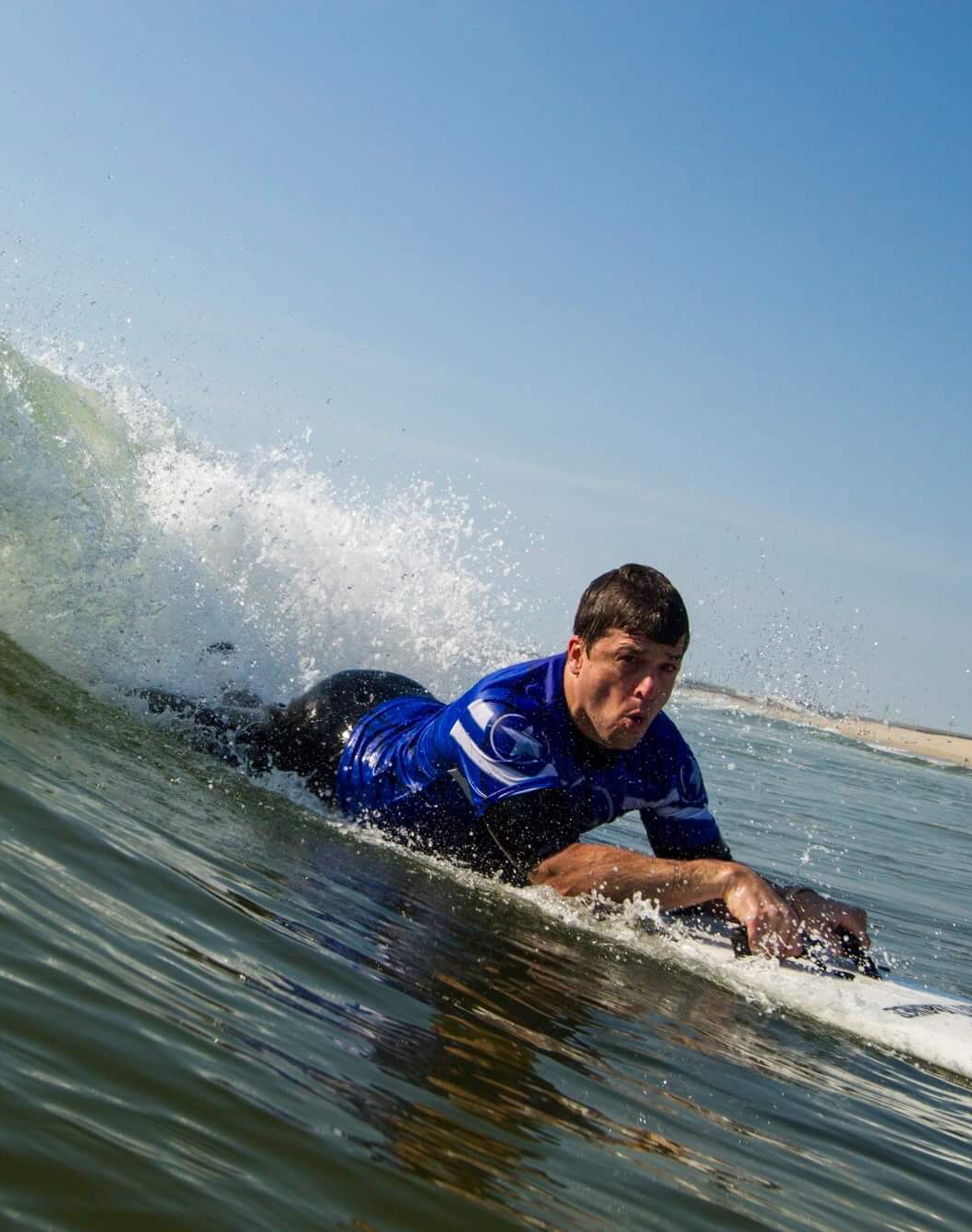Paralysis Under Pressure: A Conversation with Dr. Aaron Phillips and Julie Verlinden
Hello and welcome to ONWARD Journeys. This is our multimedia blog that shares the latest spinal cord injury (SCI) research, advocacy, and stories. We will explore the various journeys taking place in this ecosystem – from research developments to personal breakthroughs. We will bring you these highlights through articles, video interviews, and first-person narratives from changemakers making a difference in the SCI Community.
By ONWARD

ONWARD Journeys: A Conversation with Dr. Aaron Phillips and trial participant Julie Verlinden
Our first post is “Paralysis Under Pressure: A Conversation with Dr. Aaron Phillips and Julie Verlinden.” “Paralysis Under Pressure” is the title of a prize-winning scientific paper from Dr. Phillips, an Associate Professor at the University of Calgary and an ONWARD consultant. Julie, who has a spinal cord injury, was a participant in a feasibility study evaluating the ability for investigational ARCIM® Therapy to address blood pressure instability after SCI. Our discussion is centered around the challenges facing and therapies addressing a vastly underserved need in the SCI Community – Orthostatic Hypotension, or SCI-related low blood pressure.
Low blood pressure after SCI is a critical unmet need, impacting nearly three-quarters of all people with SCI. We spoke to Julie about her own experience with Orthostatic Hypotension and how it affected her daily life. We also learned from Dr. Phillips about the latest research and developments in the field.
Q: Dr. Phillips, we’ll start with you. Before we get into your research, what drew you into this field in the first place?
Dr. Phillips: An uncle of mine was a scientist, particularly in the HIV space, but he was very well established. I always admired him, and I was going to focus on HIV science. I was still intending to do that when my PhD started. And in my PhD, I met a friend who previously had a spinal cord injury – actually, he was an engineer in the lab. And he had unstable blood pressure. Visiting at his house, I got to see all the blood pressure devices he had around – some for short term blood pressure [management], others for long term, and I just got really interested in how much it impacted his life. From there, I’ve never looked back. It’s been super rewarding.
Q: Can you tell us how a spinal cord injury impacts blood pressure and why it is such a pressing problem?
Dr. Phillips: The areas responsible for controlling blood pressure are in your brain, and those require communication with and control over blood vessels. In order to keep blood pressure stable, that communication has to always be intact. So when someone has a spinal cord injury, this communication line is broken and quite often the brain can no longer control those blood vessels. And therefore blood pressure becomes unstable. We know that long term exposure to swings in blood pressure, high and low – hypertension and hypotension – leads to acute symptoms, things like lightheadedness, dizziness, in some ways, confusion, cognitive issues, tiredness, and fatigue.
“We know that long term exposure to swings in blood pressure, high and low – hypertension and hypotension – leads to acute symptoms, things like lightheadedness, dizziness, in some ways, confusion, cognitive issues, tiredness and fatigue.”
Q: Julie, we’ve heard from Dr. Phillips about the science behind blood pressure instability. First of all, can you share with us more about your journey?
Julie: I had a major car crash around two years ago now, which gave me a spinal cord injury. At that moment, when you get a diagnosis like that, your world just collapses. And you start doing your own research about what is out there and what is happening with me – is there anyone that can help me? And that’s basically how I ended up finding ONWARD as well.
Q: What kinds of symptoms did you experience firsthand, and how did they impact your life?
Julie: Well, first, like the very early stages after a spinal cord injury, I was basically not aware of the fact that I was having these symptoms, because there’s so much changing in your body at the time. You’re not used to all of the new things happening. But after a while, I started realizing, ‘Okay, this is not normal.’ I was feeling very fatigued all the time. I had blurred vision. I was basically passing out, let’s say, 10 times a day, which was extreme in my case. But yeah, that happened. My cognitive capacities, like focusing for a long period of time was impossible. I was sleeping a lot. So basically having no energy.
Q: And you were coming from being a student, a PhD student in an intense program. So that must have been a huge impact, just even the blood pressure alone, to your daily activities.
Julie: Yeah, there’s the physical side of not being able to move around the way you used to do and yeah, having less power physically. But also the mental impact was huge. When you pass out 10 times a day or even more, life becomes very, very hard. And academia or doing a PhD is no longer part of your daily reality. So that was just impossible.
“When you pass out 10 times a day or even more, life becomes very, very hard.”
Q: Did you see a doctor for the blood pressure, specifically? And what did they tell you?
Julie: I saw the the regular doctors – the neurosurgeons and the neurologist at the hospital where I was treated, and they told me that there was nothing really that could help. I mean, of course, there were the compression socks and the abdominal binders, which I tried in many different combinations. But it just didn’t help. And then they suggested switching to medication. But because of the many side effects of that medication, I wasn’t really, let’s say keen on taking even more tablets or pills. So I’ve tried the options, but didn’t really work for me.
Q: Dr. Phillips, Julie’s story and some of the therapies that she tried, is that pretty typical? What are the current treatments for blood pressure instability for people with SCI? And how effective are they in treating it?
Dr. Phillips: Julie’s journey, in terms of her treatment, and honestly, I got goosebumps when you were talking about how severe orthostatic hypotension is so life-changing. And I’m looking forward to hearing about how you’re doing now. But Julie’s condition and the ways that she was treated are pretty standard. The primary approaches, as Julie mentioned, are compression garments. These are stockings and really tight binders that kind of go around your abdomen. There is actually not any strong evidence that they work effectively for blood pressure. So I’m not surprised that Julie said that they didn’t really help her very much. So then we switch gears into pharmacology. None of these approaches really have strong evidence that they work based on the available evidence that’s out there.
Q: So the current therapies aren’t really promising. You have been at the forefront of developing a new therapy to address this problem – precise, targeted spinal cord stimulation. Can you explain how that works?
Dr. Phillips: We’ve developed a new therapy for stabilizing blood pressure after spinal cord injury, it’s been about seven years baking, but it’s starting to have a positive impact on folks in our trials. It involves using electrical stimulators, which really is adapted from technology that’s been around for decades. With our approach, what’s different is we’ve learned how we can stimulate very specific anatomy within the spinal cord that’s responsible for blood vessel control, and thereby blood pressure control. And by stimulating this area electrically, we can reawaken those areas that I talked about earlier that are disconnected from the brain due to the spinal cord injury, and we can elevate blood pressure. And we can do this in a matter of seconds. And we can stabilize blood pressure for hours and even days on end. You’re seeing in some of the trials, the devices and the approaches are still working years later.
“I was tired all the time, passing out, life had become very, very difficult. And now since having the implant, I switch it on in the morning. And I don’t pass out, I have enough energy to do all of my usual activities…”
Q: Julie, I see you nodding a lot when Dr. Phillips was responding to that. That’s because you signed up for the STIMO HEMO study. You received an implantable device, which helps you elevate your blood pressure and address blood pressure instability. Can you tell us what led you to participate in this study in the first place?
Julie: Being a researcher myself, but in a very different domain, I was always triggered by what is out there in science? What are they doing? What are they trying? And I still remember the day that I was in the hospital like scrolling the internet, trying to find any form of help for my condition. And when I saw the STIMO HEMO advertisement, the profile honors, and .NeuroRestore, I was immediately triggered. I had the feeling it was the first time that there was some sort of treatment in the pipeline. And of course, at first, I was also skeptical and scared about another surgical procedure. But after having met the team and the doctors and having the full explanation of how the system works, I was convinced that okay, I want to try that. And not only for myself, but also for the other people and being a pioneer to help bring this on the market and help more people out there with spinal cord injuries.
Q: What impact has this therapy had on addressing your blood pressure challenges?
Julie: I think you can summarize it as a life-changing impact. Before the implant, as I mentioned before, my blood pressure issues were so severe, that I could basically do nothing. I was tired all the time, passing out, life had become very, very difficult. And now since having the implant, I switch it on in the morning. And I don’t pass out, I have enough energy to do all of my usual activities, academia as well, but also rehabilitation, going out with friends. Just having a life and having energy to do stuff. Which is wonderful.
Q: I imagine resuming some of those daily life activities from going back to school to going out with friends also impacts yourself mentally.
Julie: When people ask me how does it feel like, what do you feel when the stimulation is on, I explain them that it’s sort of an oxygen boost inside my brain. And I think maybe that’s the best description that I can give like when I switch it on in the morning, there’s oxygen flowing in and then I’m ready to go. So it has a huge mental impact.
Q: Julie, we know that about three quarters of people with SCI have blood pressure instability. Based on your experience, what message would you have for those who are struggling with this issue?
Julie: I would say ‘Hang on there a bit more.’ Based on my experience with this therapy with the ARCIM Therapy, I can definitely say that, okay, change is on its way and there’s something out there that can help you. Just hang in there. Be courageous and we’re all in this together, the SCI Community.
“…change is on its way and there’s something out there that can help you.”
We will be back with more ONWARD Journeys, so stay tuned!
*All ONWARD devices and therapies, including but not limited to ARCIM®, ARCEX®, ARCBCI™, and ARC Therapy™, alone or in combination with a brain-computer interface (BCI), are investigational and not available for commercial use.


